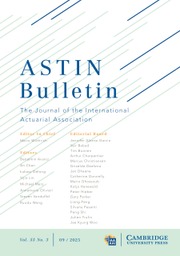Article contents
Collaborative and Parametric Insurance on the Ethereum Blockchain
Published online by Cambridge University Press: 07 November 2025
Abstract
This article introduces a blockchain-based insurance scheme that integrates parametric and collaborative elements. A pool of investors, referred to as surplus providers, locks funds in a smart contract, enabling blockchain users to underwrite parametric insurance contracts. These contracts automatically trigger compensation when predefined conditions are met. The collaborative aspect is embodied in the generation of tokens, which are distributed to surplus providers. These tokens represent each participant’s share of the surplus and grant voting rights for management decisions. The smart contract is developed in Solidity, a high-level programming language for the Ethereum blockchain, and deployed on the Sepolia testnet, with data processing and analysis conducted using Python. In addition, open-source code is provided and main research challenges are identified, so that further research can be carried out to overcome limitations of this first proof of concept.
MSC classification
Information
- Type
- Research Article
- Information
- Copyright
- © The Author(s), 2025. Published by Cambridge University Press on behalf of The International Actuarial Association
References
- 1
- Cited by

